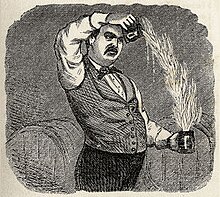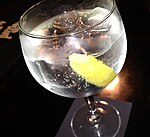
A cocktail is a mixed drink, usually alcoholic. Most commonly, a cocktail is a combination of one or more spirits mixed with other ingredients, such as juices, flavored syrups, tonic water, shrubs, and bitters. Cocktails vary widely across regions of the world, and many websites publish both original recipes and their own interpretations of older and more famous cocktails.
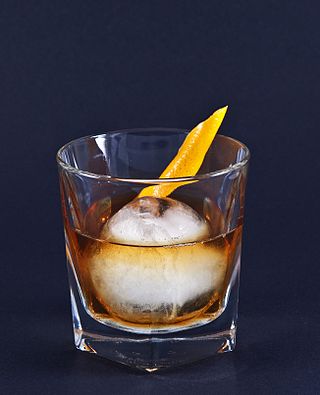
The old fashioned is a cocktail made by muddling sugar with bitters and water, adding whiskey or sometimes brandy, and garnishing with an orange slice or zest and a cocktail cherry. It is traditionally served with ice in an old fashioned glass.

The Zombie is a Tiki cocktail made of fruit juices, liqueurs, and various rums. It first appeared in late 1934, invented by Donn Beach at his Hollywood Don the Beachcomber restaurant. It was popularized on the East coast soon afterwards at the 1939 New York World's Fair.

A bitters is traditionally an alcoholic preparation flavored with botanical matter for a bitter or bittersweet flavor. Originally, numerous longstanding brands of bitters were developed as patent medicines, but now are sold as digestifs, sometimes with herbal properties, and as cocktail flavorings.

The martini is a cocktail made with gin and vermouth, and garnished with an olive and/or a lemon twist. Over the years, the martini has become one of the best-known mixed alcoholic beverages. A common variation, the vodka martini, uses vodka instead of gin for the cocktail's base spirit.
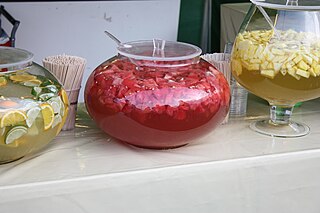
The term punch refers to a wide assortment of drinks, both non-alcoholic and alcoholic, generally containing fruits or fruit juice. The drink was introduced from the Indian subcontinent to England by employees of the East India Company in the late 17th century. Punch is usually served at parties in large, wide bowls, known as punch bowls.

A bartender is a person who formulates and serves alcoholic or soft drink beverages behind the bar, usually in a licensed establishment as well as in restaurants and nightclubs, but also occasionally at private parties. Bartenders also usually maintain the supplies and inventory for the bar. As well as serving beer and wine, a bartender can generally also mix classic cocktails such as a Cosmopolitan, Manhattan, Old Fashioned, and Mojito.

Eggnog, historically also known as a milk punch or an egg milk punch when alcoholic beverages are added, is a rich, chilled, sweetened, dairy-based beverage. It is traditionally made with milk, cream, sugar, egg yolks, and whipped egg whites. A distilled spirit such as brandy, rum, whiskey or bourbon is often a key ingredient.

Liquor or distilled beverages are alcoholic drinks produced by the distillation of grains, fruits, vegetables, or sugar that have already gone through alcoholic fermentation. Other terms for liquor include spirit, spirituous liquor or hard liquor. While the word liquor ordinarily refers to distilled alcoholic spirits rather than beverages produced by fermentation alone, it can sometimes be used more broadly to refer to any alcoholic beverage.
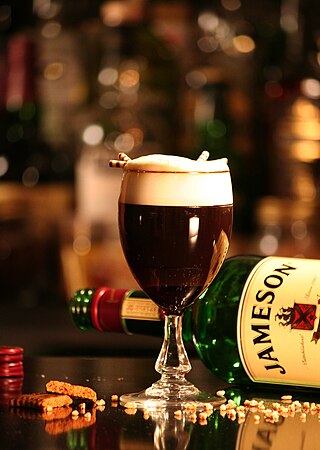
A liqueur coffee is a caffeinated alcoholic drink that consists of a shot of liqueur, mixed with coffee. It is typically served in a liqueur glass, often accompanied with cream and sugar. Coffee liqueur beverages are served in different fashions and can be found throughout many countries. One of the most popular liqueur coffee beverage is commonly known as Irish coffee. Liqueur coffee beverages are largely classified as cocktails as well as digestifs which are aimed at aiding the digestive process typically after a meal.

Various unique terms are used in bartending.

A shooter, or shot, is a small serving of spirits or a mixed drink, typically consumed quickly, often in a single gulp. It is common to serve a shooter as a side to a larger drink.
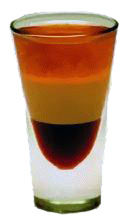
The B-52 cocktail is a layered shot composed of coffee liqueur (Kahlúa), Irish cream, and Grand Marnier. When prepared properly, the ingredients separate into three distinctly visible layers.

Cocktail garnishes are decorative ornaments that add character or style to a mixed drink, most notably to cocktails.

A "fizz" is a mixed drink variation on the older sours family of cocktail. Its defining features are an acidic juice and carbonated water. It typically includes gin or rum as its alcoholic ingredient.
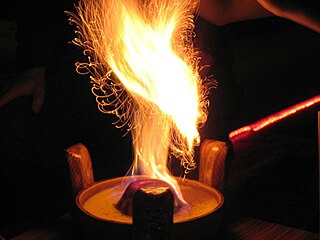
Flaming volcano is a large tropical group cocktail typically made with rum, brandy, pineapple juice, orange juice, and orgeat syrup. Many variations exist, and the cocktail in the 21st century is more about the presentation than an adherence to a set list of ingredients. It is usually a multi-user drink, served to a group in a special vessel known as a volcano bowl, which is a decorative ceramic bowl designed with a rising central hub feature resembling a volcanic cone. The cone includes a "crater" reservoir which can be partially filled with rum or another flammable liquor. The crater liquor is carefully ignited when serving, creating a mild volcanic ambiance with its central blue flame.

Death in the Afternoon, also called the Hemingway or the Hemingway Champagne, is a cocktail made up of absinthe and Champagne, invented by Ernest Hemingway. The cocktail shares a name with Hemingway's 1932 book Death in the Afternoon, and the recipe was published in So Red the Nose, or Breath in the Afternoon, a 1935 cocktail book with contributions from famous authors. Hemingway's original instructions were:
"Pour one jigger absinthe into a Champagne glass. Add iced Champagne until it attains the proper opalescent milkiness. Drink three to five of these slowly."

A lemon drop is a vodka-based cocktail that has a lemony, sweet and sour flavor, prepared using vodka, triple sec, and fresh lemon juice. It has been described as a variant of, or as "a take on", the vodka martini, but is in fact closer to a white lady variant. It is typically prepared and served straight up – chilled with ice and strained.

The craft cocktail movement is a social movement spurred by the cocktail renaissance, a period of time in the late 20th and early 21st century characterized by a revival and re-prioritization of traditional recipes and methods in the bar industry, especially in the United States. The renaissance was followed by innovation and new techniques, and the movement has spread globally, now forming part of global cuisine.


